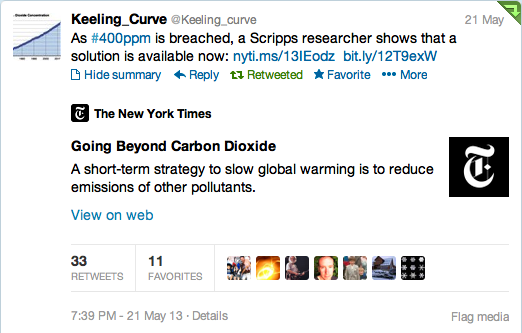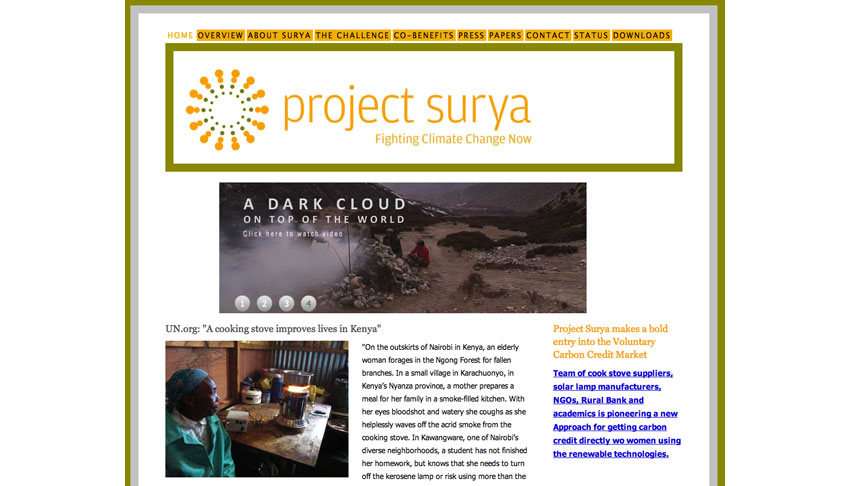When it comes to climate change and energy transition, reaching global — or even national — consensus on what we want is not an easy task. There are so many ways we could go. In order to speed up the process of decarbonising our societies, here is a proposal from scientists: let’s focus on something we don’t want, and which is relatively simple to eliminate: the black carbon and methane emissions, the so-called short-lived climate pollutants, which allegedly account for as much as 40 percent of current global warming.
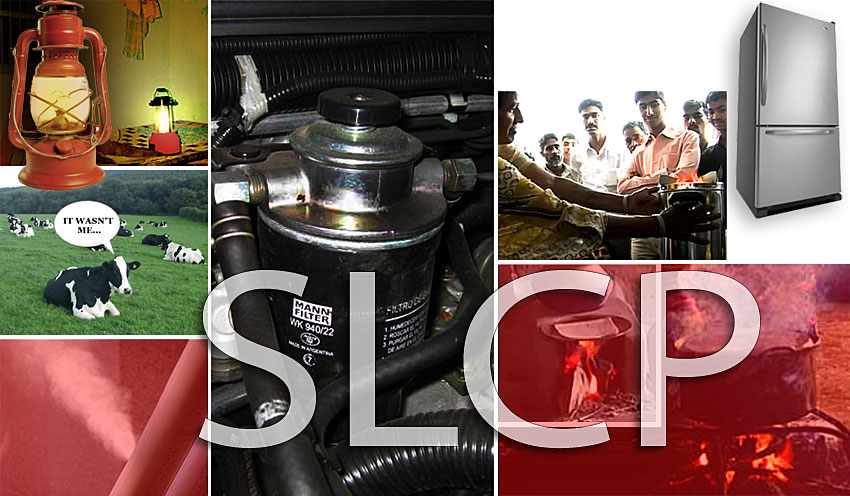
By Mik Aidt
Government and state agencies keep meeting at summits and conferences to discuss how to deal with the rising CO2-levels in the atmosphere. And they keep saying they need more time to develop greenhouse gas-reduction programmes. But the tipping-point clock is ticking, the CO2-levels keep rising when they should be falling. Time is running out for us, if we want to save our grandchildren from disaster.
Under this kind of time pressure, here is one thing we really have no excuses not to deal with instantly within our own domains and at a local and national level: Campaign aggressively against the SLCPs! Ban them where ever possible! Invest in education about them!
Because… who have heard of the SLCPs? Have you?
They are the Short-Lived Climate Pollutants. Black carbon, also called soot. Diesel cars and trucks, biomass cookstoves and brick kilns are among the most significant sources of them. Methane emissions from livestock production, agriculture and waste disposal are another one of them. Hydrofluoro-carbons which are used in cooling systems are a third group. And there are more.

Reductions of these short-term pollutants do not require 160 nations to sign on a piece of paper. The issues with these climate pollutants can be addressed by bottom-up solutions, assisted by NGOs and by individual governments. Whenever a nation takes action against them, the benefits will accrue to the people of that nation.
In other words: there are a bunch of good reasons for focusing on the reduction of black carbon and methane emissions. You reap immediate health benefits and health cost savings, while you also greatly reduce the hazards that are expected from climate change during this century.
Article in New York Times
I learned about the SLCPs from Durwood J. Zaelke, founder of the Institute for Governance and Sustainable Development, and Veerabhadran Ramanathan, a professor and a scientist of atmospheric and climate sciences at the Scripps Institution of Oceanography at the University of California, who published an article in the New York Times about these short-lived climate pollutants on 6 December 2012, at the time when the United Nations’ climate talks took place in Doha.
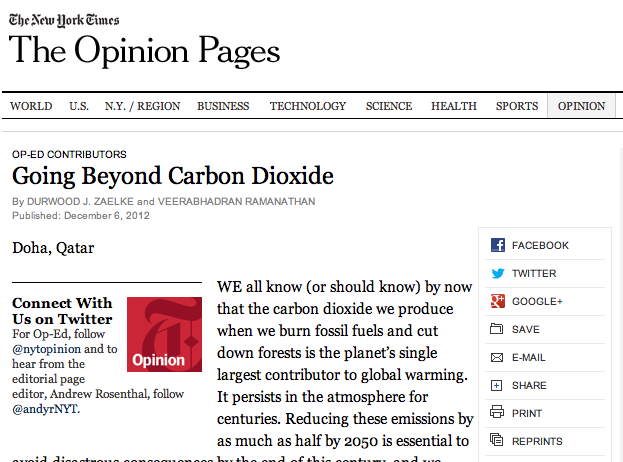
In the article, Durwood Zaelke and Veerabhadran Ramanathan suggest what sounds to me like a wise short-term strategy for what should be done with full force, since we want to reduce the dangers of the future climate change catastrophe caused by greenhouse gas emissions: Instead of only focusing on CO2 emissions, we could put a higher focus on four other climate pollutants: the black carbon, a component of soot; methane, the main component of natural gas; lower-level ozone, a main ingredient of urban smog; and hydrofluoro-carbons, or HFCs, which are used as coolants.
They account for as much as 40 percent of current global warming, and we will be able to slow this warming quickly by cutting the emissions of these four pollutants, Zaelke and Ramanathan explain in their article:
“Unlike carbon dioxide, these pollutants are short-lived in the atmosphere. If we stop emitting them, they will disappear in a matter of weeks to a few decades. We have technologies to do this, and, in many cases, laws and institutions to support these cuts. Moreover, President Obama has the executive authority to move ahead aggressively on these pollutants, as he did last year in ordering substantial reductions in auto and truck emissions. By doing so, he may persuade other countries to follow.
Such reductions, if they occurred worldwide, would have the potential to slash the rate of global warming by half by midcentury — equivalent to wiping out the warming we have experienced over the last 50 years. These reductions would also prevent an estimated two to four million deaths from air pollution and avoid billions of dollars of crop loss annually, according to a study commissioned by the United Nations Environment Program and the World Meteorological Organization.”
A short, informative film about Short-Lived Climate Pollutants (SLCP) and their effects on the climate of the Earth, made by Frans and Staffan, two students in Sweden. Published on YouTube.com on 30 October 2012.
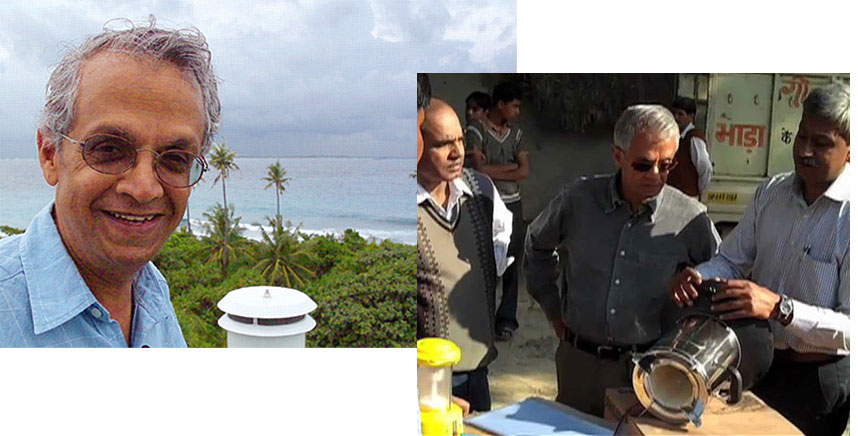
Global coalition
Professor Veerabhadran Ramanathan is a member of a Science Advisory Panel for a new coalition which was established in beginning of 2012 to promote the SLCP focus under the United Nations. The coalition was given the straight-forward but rather long name The Climate and Clean Air Coalition to Reduce Short-Lived Climate Pollutants.
This coalition is the first global effort to treat short-lived climate pollutants as an urgent and collective challenge. So far 25 countries are partnering along with the World Bank, the European Commission, the United Nations’ environment and development programs, the World Health Organization, the American President’s administration, and several environmental organisations.
USA, Canada, Australia, UK, Germany, the Nordic countries, France, Italy, Japan as well as Bangladesh, Ghana, Mexico and the Maldives are all in it. But… what are the other 165 countries doing? Where is China? India? Russia? Brazil? Why aren’t they stepping in here?
Technologies are available
At a seminar in the UN headquarter in Geneva on 20 May 2013, Dr Ramanathan elaborated on the figures:
“When you release CO2, half of that will be circulating the globe 100 years from now, and 20 percent a thousand years from now. Short-lived climate pollutants are much, much shorter [in their presence in the atmosphere]. If we take action with landfills and sewage, most [methane] will be gone within a few months. [If we take action on] black carbon, most of it will be gone in a few weeks. If you think of the 2°C degrees [heating of the atmosphere] as a guardrail that you do not want to go past, if you combine CO2 with short-term reductions, then there is at least a 50 percent chance that you can avoid exceeding the two degrees,”
Citing a recent study published by the California Air Resources Board (‘Black Carbon and the Regional Climate of California’, January 2013), Dr Ramanathan observed:
“The fastest way to mitigate simultaneously indoor and outdoor deaths as well as loss of crops, global warming and sea level rise, glacier melting and disruption of monsoon rainfall, is to reduce drastically black carbon emissions from the diesel transportation and rural residential sectors. Technologies are available to reduce black carbon from these sectors by 70 percent to 99 percent.”
The Californian study has showed that ambient air black carbon concentrations over the state had declined by 90 percent since 1960, due to improved fuels and vehicle emissions technologies, despite a five-fold increase in the use of diesel fuel oil, largely by vehicles.
What needs to be done
Dr Ramanathan called the Climate and Clean Air Coalition “the second front against climate change” and commented on the speed with which the partnership has grown. “Why have policymakers responded so rapidly?” he asked. Because “reduction of SLCPs has public health and food security benefits that will be realised in our lifetimes.”
Black carbon emissions can be reduced significantly in the next few decades by simply forcing all car owners to use particulate filters on cars and trucks, and by switching to low-sulfur diesel. By employing those strategies, California has been able to cut the warming effect from diesel emissions by nearly half since the late 1980s.
In addition, we can further reduce emissions of black carbon and carbon monoxide which produces lower-level ozone in the developing world simply by turning to efficient biomass cook stoves instead of using traditional mud stoves, by replacing kerosene lamps in villages with solar lamps, and by deploying modern brick kilns.
A project called Surya, for instance, is working on this by replacing highly polluting cookstoves traditionally employed in rural areas with clean-cooking technologies. As you can see in the video below, Dr Ramanathan is a Co-Principal Investigator for Project Surya.
Methane emissions can be cut by nearly a third by reducing leaks from gas pipes, coal mines and hydraulic fracturing, by capturing methane from waste dumps, water treatment plants and manure, and by cutting emissions from rice paddies.
Saving millions of lives
According to the estimates of a landmark global study published in The Lancet (Lim SS, et al, 2012), indoor air pollution was responsible for some 3.5 million deaths annually in 2010, while outdoor air pollution caused about 3.3 million deaths. Most of these deaths are due to excessive exposures to particulate pollution, which includes significant black carbon particles.
Does it make common sense to take action? It should seem so.
If politicians would agree on local or national levels that SLCPs are simply something we don’t want, and which we therefore must campaign against, ban, legislate and create awareness about, and by all means eliminate as quickly as possible, then it ought to be a much easier path for politicians to take action on than solving the problem with our dependency on fossil fuels. Not that this doesn’t need to be dealt with, but considering the time pressure… Here is a place to start.
A bit of serious action from local and national politicians’ side would have a psycological effect, after all these years now of inadequate regulation of the CO2 emissions. It could transmit new signals of hope for the future. In this way they would not only be combatting air pollution sickness and climate change, they would also be combatting the general feeling of apathy, hopelessness and carelessness among individuals which for so long has been putting a brake on a transition towards climate safety.
So dear decission-makers and legislators: what is holding you back?
[Comments are welcome – enter below.]
• Reuters – 19 June 2013:
European parliament committee backs ban on planet-warming F-gases
The European Parliament’s Environment Committee backed a sweeping ban on the use in fridges and air conditioners of fluorinated gases – greenhouse gases that are many thousands of times more damaging than carbon dioxide. The plan, which would have to be approved by a plenary session of the parliament and by EU countries before becoming law, goes much further than a proposal from the executive European Commission. By Barbara Lewis and Ethan Bilby
• Before 31 May 2013: Cast your vote for SolarAid to scale access to solar lighting in off-grid communities in Africa by establishing a distribution network with local entrepreneurs. The project with the most votes will win a £500,000 ‘fan favourite Global Impact Award’.
globalimpactchallenge.withgoogle.com/#/solaraid
• United Nations’ home page for the coalition:
unep.org/ccac
• Veerabhadran Ramanathan’s speech in Geneva on 20 May 2013:
Ramanathan_WHA_Side_Event.pdf
• The New York Times – 6 December 2013:
Going Beyond Carbon Dioxide
By Durwood J. Zaelke and Veerabhadran Ramanathan
• UN Environment Programme – 24 May 2013:
Reducing Climate-related Air Pollution
Reducing Climate-related Air Pollution and Improving Health: Countries can act now and reap immediate benefits
• Wikipedia, the open encyclopedia:
About Climate and Clean Air Coalition – including a list of the current partners in the programme
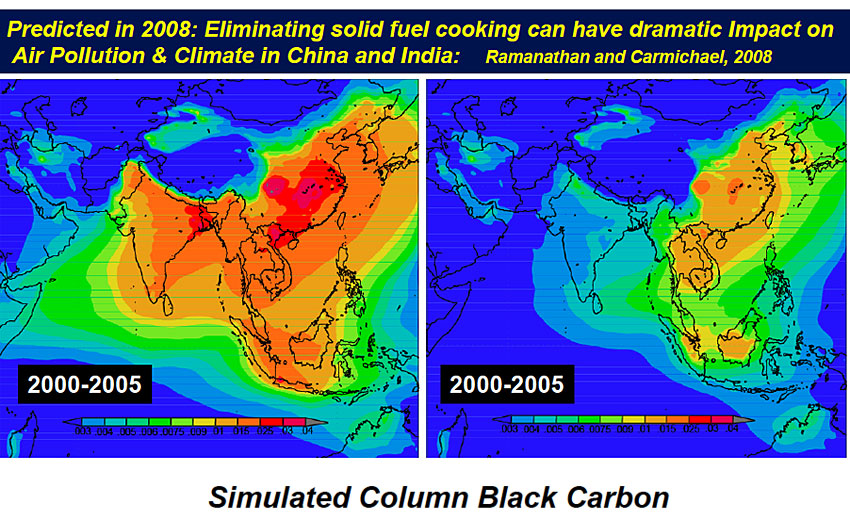
Project Surya
“Project Surya aims to mitigate the regional impacts of global warming by immediately and demonstrably reducing atmospheric concentrations of black carbon, methane, and ozone. Project Surya will replace the highly polluting cookstoves traditionally employed in rural areas with clean-cooking technologies. Metaphorically, Surya will create a black carbon hole within weeks of introducing the energy-efficient technologies. Project Surya employs innovative sensing technologies to measure the positive climate and health impacts that result from this dramatic reduction in black carbon in unprecedented scale and resolution.
In its first phase, Project Surya will target three regions in rural India: one region in the Himalayas, one region in the Indo-gangetic plains, and one region in South India for deployment. Surya will provide sustainable, effective, incentive-based plans to enable 5,000 households in each region to switch to cleaner-burning technologies such as solar cookers and other efficient stove technologies.”
Continue reading here:
projectsurya.squarespace.com/overview2

